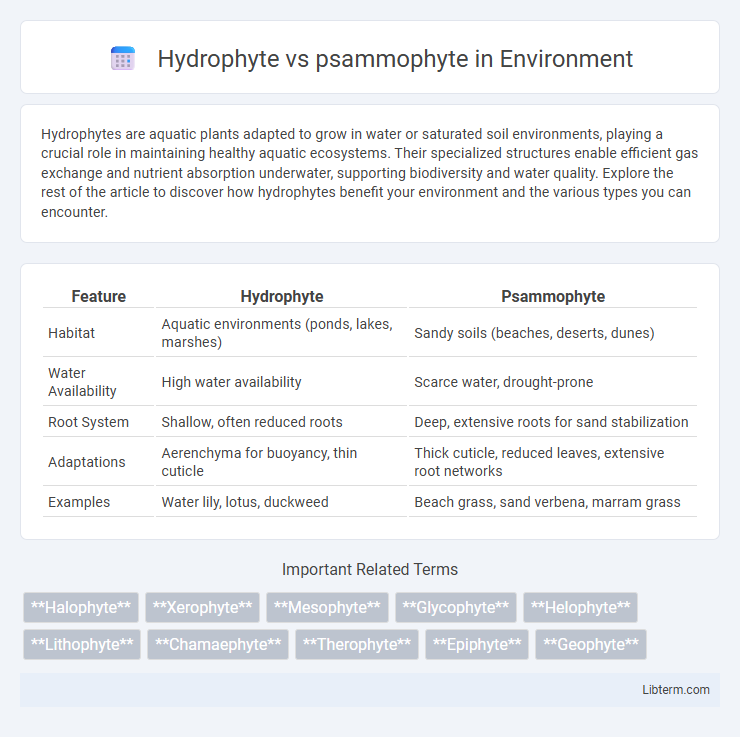Hydrophytes are aquatic plants adapted to grow in water or saturated soil environments, playing a crucial role in maintaining healthy aquatic ecosystems. Their specialized structures enable efficient gas exchange and nutrient absorption underwater, supporting biodiversity and water quality. Explore the rest of the article to discover how hydrophytes benefit your environment and the various types you can encounter.
Table of Comparison
| Feature | Hydrophyte | Psammophyte |
|---|---|---|
| Habitat | Aquatic environments (ponds, lakes, marshes) | Sandy soils (beaches, deserts, dunes) |
| Water Availability | High water availability | Scarce water, drought-prone |
| Root System | Shallow, often reduced roots | Deep, extensive roots for sand stabilization |
| Adaptations | Aerenchyma for buoyancy, thin cuticle | Thick cuticle, reduced leaves, extensive root networks |
| Examples | Water lily, lotus, duckweed | Beach grass, sand verbena, marram grass |
Introduction to Hydrophytes and Psammophytes
Hydrophytes are plants adapted to grow in aquatic environments, characterized by specialized structures such as aerenchyma for buoyancy and efficient gas exchange. Psammophytes thrive in sandy soils, often in deserts or coastal dunes, exhibiting adaptations like deep root systems and xerophytic features to survive water scarcity. These ecological groups demonstrate distinct physiological and morphological traits tailored to their respective habitats.
Defining Hydrophytes: Key Characteristics
Hydrophytes are plants adapted to grow in water-saturated environments such as ponds, lakes, and wetlands, characterized by their specialized structures like aerenchyma tissues that facilitate oxygen transport in submerged conditions. These plants exhibit flexible stems and leaves, reduced or absent cuticles, and often possess floating leaves or air-filled sacs to maintain buoyancy. Unlike psammophytes, which thrive in sandy, arid soils with drought-resistant features, hydrophytes rely on abundant water availability and demonstrate physiological adaptations for aquatic living.
Defining Psammophytes: Key Characteristics
Psammophytes are specialized plants adapted to thrive in sandy, nutrient-poor soils typically found in coastal dunes, deserts, and riverbanks. These plants exhibit key characteristics such as extensive root systems for anchorage and moisture absorption, xerophytic features like thick cuticles and reduced leaf surface area to minimize water loss, and the ability to withstand shifting substrates and high salinity. In contrast to hydrophytes, which are adapted to aquatic environments, psammophytes are drought-resistant and crucial for stabilizing sandy ecosystems through soil retention and organic matter accumulation.
Habitat Differences: Aquatic vs. Sandy Environments
Hydrophytes thrive in aquatic habitats such as freshwater lakes, ponds, and slow-moving rivers, where their adaptations enable them to absorb oxygen and nutrients directly from water. Psammophytes are specialized for sandy environments like coastal dunes and desert sands, exhibiting traits to conserve water and anchor firmly in unstable, nutrient-poor substrates. These contrasting habitat preferences highlight evolutionary adaptations to distinct moisture availability and substrate stability.
Water Adaptation Strategies in Hydrophytes
Hydrophytes exhibit specialized water adaptation strategies such as aerenchyma tissue for efficient oxygen transport in submerged conditions and thin cuticles to facilitate gas exchange and water absorption. Their root systems are often reduced or modified to thrive in saturated environments, contrasting with psammophytes that adapt to dry, sandy soils with extensive root networks for water uptake. These physiological and structural traits enable hydrophytes to survive and reproduce efficiently in aquatic habitats.
Survival Mechanisms of Psammophytes
Psammophytes exhibit specialized survival mechanisms such as deep root systems for accessing water in sandy, nutrient-poor soils and waxy leaf coatings to reduce water loss. These plants demonstrate remarkable drought tolerance through efficient water storage and physiological adaptations like stomatal regulation to minimize transpiration. Their ability to stabilize shifting sands also contributes to their survival in harsh desert-like environments.
Morphological Differences Between Hydrophytes and Psammophytes
Hydrophytes exhibit morphological adaptations such as large, thin leaves with aerenchyma tissue to facilitate buoyancy and gas exchange in aquatic environments, while psammophytes possess thick, waxy cuticles and deep, extensive root systems to conserve water and stabilize sandy soils. The stomata of hydrophytes are often located on the upper leaf surface to optimize gas exchange above water, whereas psammophytes typically have sunken or fewer stomata to reduce water loss. Differences in root structure are pronounced, with hydrophytes having spongy, less-developed roots compared to the robust, fibrous roots of psammophytes adapted for anchorage and nutrient absorption in loose, sandy substrates.
Ecological Roles and Importance
Hydrophytes play a critical role in aquatic ecosystems by providing oxygen through photosynthesis, stabilizing sediment, and offering habitat and food sources for diverse aquatic fauna. Psammophytes are essential for desert and coastal dune ecosystems, as their root systems stabilize loose sandy soils, prevent erosion, and promote nutrient cycling in nutrient-poor environments. Both plant types contribute significantly to biodiversity and ecosystem resilience by adapting to and sustaining their unique habitats.
Examples of Hydrophyte and Psammophyte Species
Hydrophytes include species such as water lilies (Nymphaea spp.), cattails (Typha spp.), and duckweeds (Lemna spp.), all adapted to aquatic environments with traits like floating leaves and air-filled tissues. Psammophytes, exemplified by marram grass (Ammophila arenaria), sand verbena (Abronia spp.), and sea rocket (Cakile maritima), thrive in sandy, coastal habitats with specialized root systems for anchoring and drought resistance. These species highlight the ecological niches and morphological adaptations distinctive to hydrophytic and psammophytic plants.
Comparative Summary: Hydrophytes vs. Psammophytes
Hydrophytes are aquatic plants adapted to water-saturated environments with specialized structures like aerenchyma for buoyancy, while psammophytes thrive in sandy, nutrient-poor soils with deep root systems for water retention. Hydrophytes exhibit features such as thin cuticles and reduced vascular tissues to facilitate gas exchange in submerged conditions, contrasting with psammophytes' thick cuticles and extensive root networks to prevent desiccation. Both plant types demonstrate unique physiological and structural adaptations tailored to their specific ecosystems, optimizing survival in either aquatic or arid sandy habitats.
Hydrophyte Infographic

 libterm.com
libterm.com